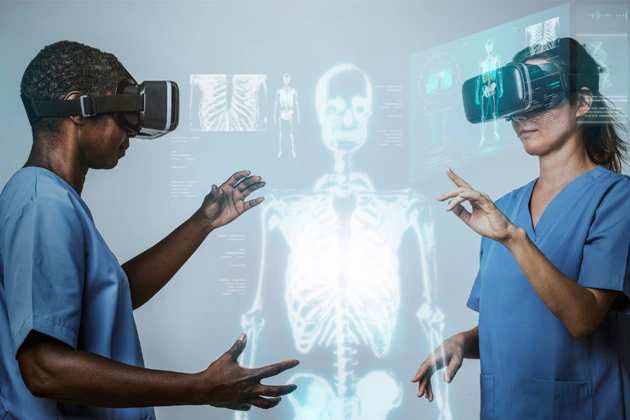The integration of artificial intelligence (AI) components into the digital twin (DT) technology unlocks a transformative power that could revolutionize organizational operations. This also applies to the healthcare sector. AI-generated digital twins use AI models in healthcare to predict future health outcomes for an individual patient. The digital twin technology itself is reshaping healthcare systems by leveraging advanced analytics, real-time data integration, and virtual simulations. The rapid development of digital twins for patients and human organs in medical research, and the use of artificial intelligence in clinical practice, has facilitated the development of effective treatment options at a lower cost and in a swift manner. The large historical datasets from previous clinical trials and other real-world data sources have facilitated this reimagination of treatments in this sector.
Digital twins can update in real-time with their corresponding physical patients and connect to multiple therapeutic and diagnostic devices. Supporting this new era of personalized medicine is crucial to address the complex regulatory, technological, and security issues involved. This article explores digital twin technology, its development process, use cases, and integration with AI to revolutionize operations, particularly in the healthcare sector.
Exploring the Digital Twin Technology
Digital twin technology is one of the fastest emerging concepts in Industry 4.0. A digital twin is a virtual copy of a real-world object functioning in a simulated environment to test its functionality and performance.
Digital Twins facilitate in-depth studies by using big data, IoT, and AI frameworks. It is beneficial to identify significant obstacles, to reduce disruption, and to analyze business opportunities. It is also necessary to model future results and to customize growth based on consumer needs.
How do you build a Digital Twin?
There are three vital elements to form a digital twin:
Historical Data: Past individual system performance records, aggregate processes, and basic structures.
Present Data: Concrete data from equipment monitors, production sources of fields and equipment, and distribution chain systems outputs. Outputs from systems of other market segments can also be used, such as customer service and buying.
Future Data: Machine learning, along with inputs from engineering.
The advantages of Digital Twins include:
- Product Tracking: A digital twin keeps monitoring the product during the entire process. IoT sensors continue to offer time-to-time updates on the performance of the product. Digital Twin processes all the data, and the output is continually enhanced.
- Predictiveness: The digital twin makes it possible to predict the future state of relevant company assets using several modeling methods. It also helps to determine the consequences of any critical issues to be resolved.
- Better Team Coordination: System automation and 24-hour accessibility to information systems allow technicians to focus more on teamwork. It leads to improved productivity and operational success.
Use Cases of Digital Twin:
-
Smart Cities
Digital Twin can dramatically improve ecologically and economically advanced towns. It enables users to create systems that guide their upcoming plans and help solve cities’ complex problems. In the event of disasters such as earthquakes, Digital Twin provides useful real-time information. It includes the areas that hospitals can be affected by, allowing local planners to take proactive action.
-
Healthcare
Digital Twin provides advantages in healthcare by updating the records and history of patient well-being. It’s easy for physicians to offer appropriate medication to their patients by leveraging digital twin technology and artificial intelligence in health care.
-
Disaster Management
Climate change has had an impact on the planet in recent years. Digital twins will continue to counter this by intelligently developing smarter infrastructure, creating strategies for incident response, and monitoring the climate crisis.
-
Automotive Field
Digital Twins are utilized in the automotive industry to create the digital prototype of a connected vehicle. The technology is used before construction starts by automobile firms to design the ideal automotive vehicle. When the vehicle enters the streets, the model analyzes the development process and possible issues.
Digital Twin and Artificial Intelligence in Healthcare
The progression of digital twins in healthcare started to gain momentum during 2010, with the rise of the Internet of Things and AI-based data analytics. By the mid-2010s, digital twins made their way into surgical planning, where virtual models of patients’ anatomy assisted surgeons in practicing and refining real surgical procedures. With the COVID-19 pandemic, interest in DTs as a tool to manage and predict the spread of the virus for determining its impact on public health has increased. Gradually, the concept of DTs extended to drug development, where drug interactions are simulated through virtual models of human physiology, reducing the time and cost of clinical trials. From 2020, AI-based DTs in healthcare have been revolutionizing patient care with unparalleled personalization and predictive power.
Digital Twin technology is emerging as a transformative power within healthcare systems, enabling healthcare providers to gather and analyze patient data from multiple sources, including wearables, electronic health records, and medical devices. By considering different characteristics, real-time physiological data, and medical history, digital twins allow medical professionals to diagnose accurately, empower patients by encouraging their participation in their own care, and monitor patients in real-time.
AI integration with DTs: A Revolutionary Approach Towards Healthcare Improvements
AI-based digital twins are among the most dominating technological trends in healthcare. While making waves by delivering personalized, preventive, and predictive care, these virtual replicas of physical entities enable healthcare providers to optimize care processes. This leads to better patient outcomes and efficiency in medical research.
Taking human artificial intelligence into consideration, AI-based digital twins also focus on working collaboratively with humans to improve their capabilities and experiences. AI uses data and algorithms to process information and execute tasks. Whereas human intelligence encompasses human traits like emotional intelligence, ethical reasoning, and creativity. The synergy between the two is where AI takes up routine human tasks to automate them, allowing humans to focus on more creative, complex, and strategic endeavors.
Digital twins with generative AI can revolutionize the way healthcare organizations operate. Gen AI has the potential to streamline digital-twin deployment. A gen-AI-based model of the digital twin of a particular individual can be used to predict outcomes at both individual and population levels.
Future of Digital Twins
Digital twins will emerge in many industries as one of the leading IT tools, especially in manufacturing. But it will also revolutionize product development and product testing in a wide variety of fields. As long as it is somehow producing data that can be collected and analyzed. Almost any generated product will have its digital twin in the future. This idea is known as a ‘digital triplet.’ It will mark the digital twin’s next stage of evolution.
For instance, Boeing has only one digital twin of a new aircraft for development purposes. For any aircraft it makes, the company would have a specific digital model. In real-time, these individual models can be fed information from linked sensors. And AI analysis can be applied to render real-time product life cycle predictions, predictive maintenance, etc. Human beings would also have their own digital triplets that gather real-time information from wearables. It can contain the specific genetic code of a person. And every individual on the planet will receive extremely individualized yet cost-effective medical care using this information in principle.
As one of the reputable business magazines in the USA, The CEO Views features articles that provide a detailed insight into the latest technological trends reshaping industries, be it healthcare or finance. Additionally, it also features articles, blogs, news, and profiles of industry experts, technological innovations, and current topics ruling the global business landscape.









